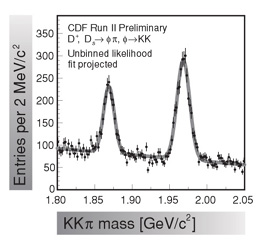 |
|
CDF approves first Run II paper by Kurt Riesselmann
Scientists at CDF have announced that they will soon release the first publication based on data obtained from Fermilab’s Collider Run II. An internal CDF seminar scheduled for March 7 is likely to be the last step of an elaborate,six-month review process.Barring any last-minute objections from members of the CDF collaboration,scientists will submit a paper on a mass measurement of particles containing charm quarks to the science journal Physical Review D. “It ’s not a major discovery,”said CDF scientist Christoph Paus,assistant professor at MIT.“It ’s bread-and-butter physics.Our measurement of the mass difference between the D+and Ds+particles is competitive with the world average.Even more important,the paper indicates:‘Hello,CDF is back.’” This is not to say that the CDF scientists or their colleagues of the DZero experiment had ever disappeared.Over the last ten years,both collaborations have published hundreds of papers based on Collider Run I, experiments that took place from 1992 to 1996.The new paper will be the first of a flood of publications expected from Run II,which started in 2001. It often takes many months or even years before a team of particle physicists is ready to publish results of a specific analysis.Interestingly enough,it can take almost as much time to convince other members of the collaboration that an analysis was done right and that its conclusions are correct. “Our collaboration has bylaws that govern the release of results,”said Paus.“The bylaws are like the constitution of CDF. For data shown at conferences or other public events a blessing of the results by the entire collaboration is necessary.”
Every time a scientist plans to share a new graphic or numeric value with someone outside the collaboration,other collaboration members must first have the chance to review the results and the methods that were used to produce the results. If an analysis is complicated and peer scientists voice many questions and concerns,this blessing process can take months,including the possibility that some results never get approved. "In early summer,2002 we calibrated the momentum scale of the detector," said graduate student Ivan Furic,who works with Paus at MIT. "We had data on the decay of D+ and Ds+ particles, and we measured their difference in mass.We produced two blessed notes,one on the calibration and one on the mass difference." Blessed results are considered preliminary,and not every blessed result gets published in a science journal.Blessed charts and numbers often are just an intermediate step of a larger analysis. In the case of the D+ and Ds+ results,the MIT scientists pursued the idea of publishing the results to document the capabilities of the upgraded CDF detector.On August 30,the CDF spokespersons agreed and officially initiated the publication process by assigning godparents,a team of usually three to four CDF experts.They named as godparents William Wester,who carried out a similar analysis in Run I;Stefano Giagu,an expert on the CDF silicon vertex trigger,a crucial piece of equipment in the data taking process;and Aseet Mukherjee,who has detailed knowledge of the analysis required for particle tracking. Godparents carefully review the work proposed for publication.Once they approve the analysis, they help the authors to obtain all approvals and to get the work published.The godparents provide guidance for the first draft of publication,and they coordinate the internal collaboration review,a process with more scrutiny than the blessing of preliminary results. It took Paus,Furic and their godparents about three months to converge on a first document.
"We released the first draft to the entire collaboration before Christmas," said Wester,who chairs the godparents committee. "We got lots of comments from individuals and groups.We then made sure that the authors addressed all issues.Our committee carefully reviewed all responses." The first round of comments focused on the scientific content of the publication.Collaboration members critically examined all aspects of the work,challenging methods and assumptions that Paus and Furic had relied on.Responding to all questions and comments took a lot of time.When all issues had been resolved,a revised draft went to the entire collaboration,asking scientists to carefully review the wording and the conclusions drawn in the paper. On March 7, Paus and Furic will present what is probably the final version of the publication. If approved,the CDF collaboration will submit the paper within a few days.The names of all 638 CDF scientists will appear on the publication. But that's not all. "For the first publication,we also wanted to recognize engineers,technicians and other non- physicists who have made significant contributions to the CDF Run II upgrade," said cospokesperson Al Goshaw. "The first author list will include an additional 169 names." Seven years after the conclusion of Run I, CDF is back.
ON THE WEB:
|


